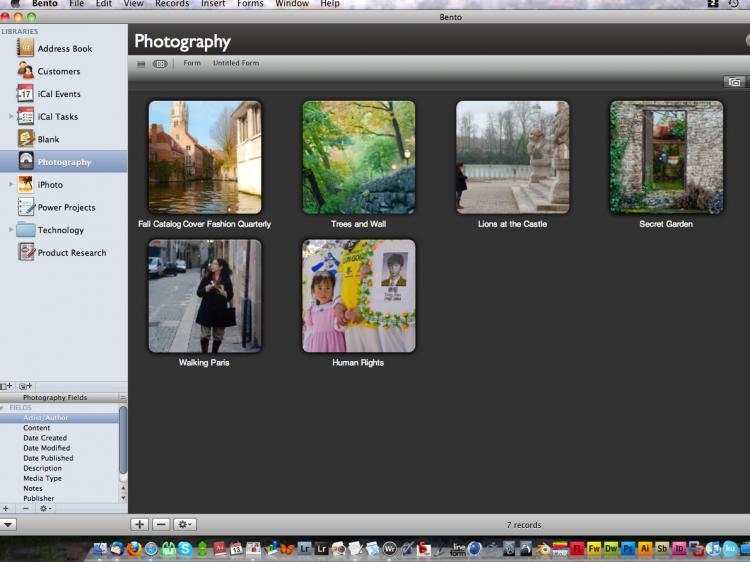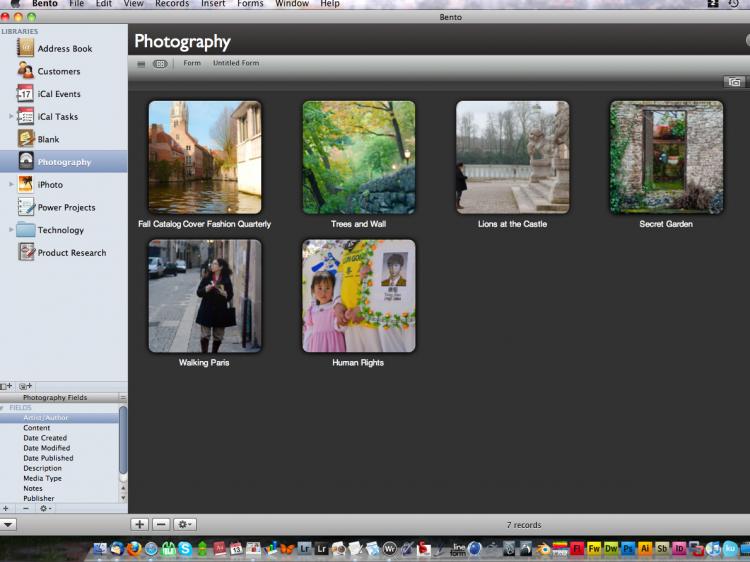Bento functions as a place to keep track of things—whether it be schedules and meetings, personal inventory, or a place to store your recipes. It has templates for just about everything you need, including professional and home categories, and allows for the creation of custom templates. It can also store multiple databases, which are displayed on a small column within the workspace.
Filemaker’s Bento is primarily for home users and small businesses, while Filemaker Pro is geared toward large businesses and professionals. Essentially, Bento is the database system for anyone who doesn’t know much about databases. It manages to take a complex system and makes it easy enough for just about anyone to use. It is also pleasantly affordable.
New in Bento 3
The three major updates in Bento 3 include password protection, photo integration, and new sharing capabilities. Each of these updates also has several associated features.
Password protection is arguably the most important addition to Bento. It was among the more demanded features from users of previous versions. Bento 3 is encrypted and cannot be accessed without a password—if you choose to make it so. The inability to do this in previous versions, combined with how easy it is to change or move data, make the updated version a worthwhile purchase.
There are a few options for password-protection. Using the new “Encrypted” field type, you can make a specific field that only you can view, which could come in handy for information such as login passwords, bank information, or product keys.
Those most concerned about file safety may choose the highest security option and make their entire Bento database password protected.
There are also a few new sharing features. Bento 3 allows users to share their database with up to five other users over a local area network (LAN). Essentially, this would come in handy for a specific database accessible from multiple computers, either at home or at a business. However, the downside is that each computer will need to have a separate copy of Bento 3 installed, and it is limited to computers that are within your network—in other words, they can’t be shared over the Web.
For sharing databases, users have the option of selecting which files are shared and which ones are kept private. Access can be limited to view only, or it can be made so other users can make additions and changes. The program also offers users a sharing password, requiring other users to know the password to access the database.
Photo Layout
Pictures play a big part in Bento 3 and several elements of the databases are now photo-friendly. I found this feature to be very helpful when sorting through database forms, and something about it is just easier on the eyes.
This update makes for a much more pleasant experience as users no longer have to endure a tedious, text-heavy page, but can instead enjoy images assigned to represent forms in a database.
This feature is not only aesthetically pleasing; it also makes it a lot easier to find what you’re looking for within a specific database. For example, if you have a database of a DVD collection, you can make an image for each movie to represent each form. Or if you are a business owner, you can make a list of employees and view them by picture, rather than having to read through a whole list.
There are actually a few new viewing options that work with pictures. The Grid view shows a grid of image thumbnails to represent each form. It can also be made to display select information below the photo, such as a brief description or a phone number, which will link from within the associated form so you don’t have to type it twice.
The Table view, which looks more like an Excel document, also now has a column that displays pictures.
Bento 3 also has a handful of other new features including a few new themes and 10 new templates to customize your databases.
In addition, files can now be created to store multiple databases. For example, if there are several databases with similar themes, you can place them in a file together which will help keep things organized if you have several databases to manage.
And unlike previous versions of Bento, users can now edit forms without having to switch to a special edit section, as everything can now be done from the main workspace.
In a Nutshell
Keep in mind that Bento is designed for the casual user, and this aspect has not changed in version 3. Users who are skilled in MySQL, Oracle, or other database systems may not have much need for Bento—unless they’re looking for a simple and visual database program.
For casual users and those with little or no database knowledge, Bento is one of the better programs on the market for homes and small businesses. It doesn’t require any previous database experience and is fairly easy to figure out.
Should Bento or Bento 2 users make the upgrade to Bento 3? This all depends on what you’re looking for. The main additions to Bento 3 are password protection, the implementation of photos as a method to recognize files, and the ability to share files over a LAN. The password protection and the use of photos are great to have and, in my opinion, are well worth the $29 cost to upgrade.







